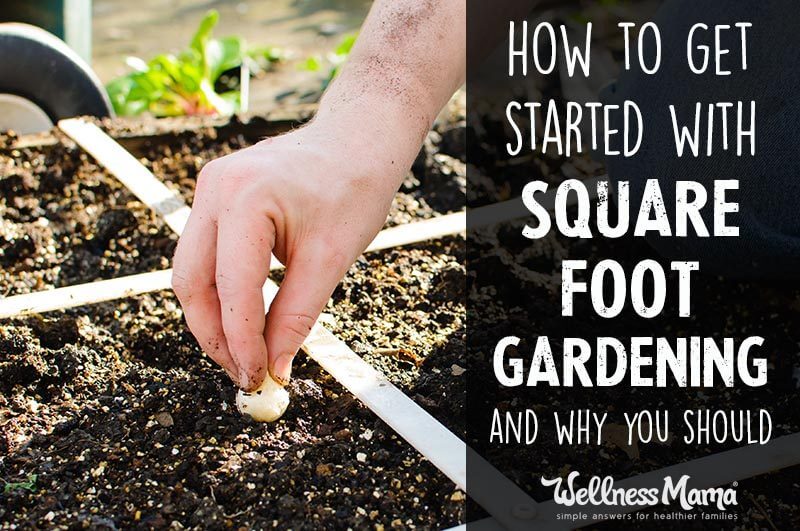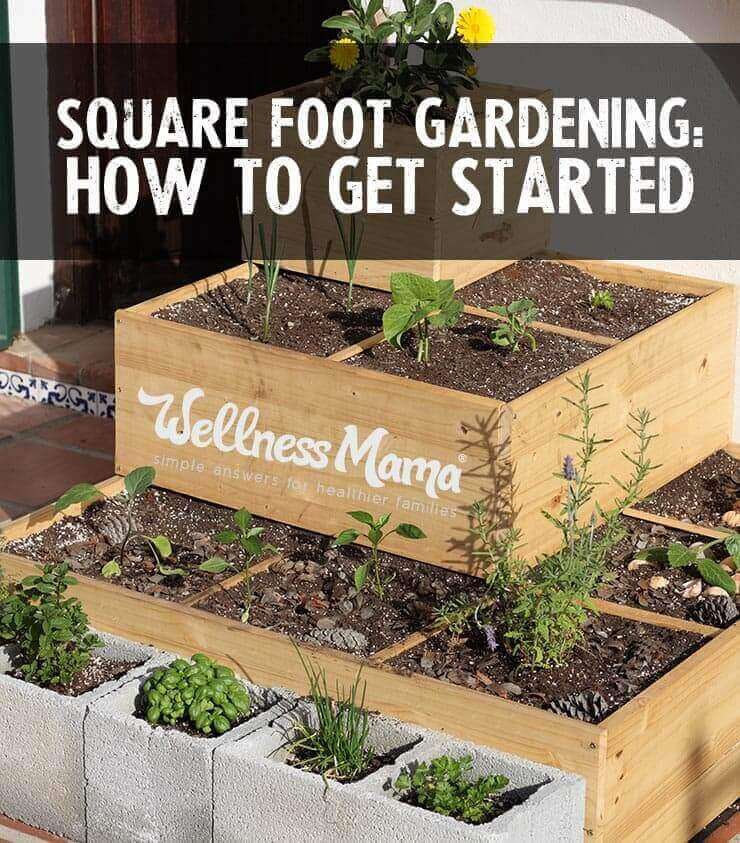

A little research on starting a backyard garden will quickly show there are many (maybe too many?) ways to plan your own plot. But don’t let it overwhelm you. Of the many methods I’ve tried in our garden over the years, Square Foot Gardening makes a tidy, productive garden possible even for those with little know-how, time, or space, and the neighbors won’t even mind looking at it!
What Is Square Foot Gardening?
In the early 1980s retired engineer Mel Bartholomew came up with an easily replicated concept to grow more food in less space, coining the term “Square Foot Gardening™.” His method has not lost popularity in the years since and has been improved and modernized. (1)
A Square Foot Garden has several unique characteristics:
- Small, uniform raised beds (usually 4 x 4)
- Rich amended soil
- A physical grid dividing the surface of each bed into 1’ squares
- A set number of plants per square foot
Square foot gardens can be a simple wooden frame or can even become more elaborate vertical gardens:

While I love the idea of a sprawling garden in all its glory, you can see how the tidy, manicured look of a Square Foot Garden might be appreciated in a variety of residential settings.
The Benefits of Square Foot Gardening over Traditional Gardens
In the traditional row garden, between every long row of green goodness there is an equal bare space for an aisle or path. Not only are these paths taking up space in your yard, they are prime territory for weeds and compact nearby roots.
Now imagine a small 4 x 4 foot raised bed capable of growing all the produce a traditional garden can. The uniformly spaced plants crowd out weed growth, the ideal soil mix reduces the need every inch of soil remains aerated and fluffy, all areas of the bed can be reached easily for tending, and the small footprint means water savings.
And it gets better:
With Square Foot Gardening’s easy but precise formula for deciding what to plant in each square foot, simply based on a plant’s general size at maturity, amateur gardeners are spared having to learn every plant’s particular spacing and nutritional needs.
Sound too good to be true? How about this claim:
Square Foot Gardening yields 100% of the harvest of a traditional garden in 80% less space, and with a mere 2% of the work. (2)
Here’s how to get started on your own Square Foot Garden bed in a few easy steps:
How to Start Square Foot Gardening
Before you get started creating your new garden, there’s a few things to keep in mind:
1. Size it up
No clever garden design can make up for lack of sun or poor drainage. Track sun and shade patterns to find a location with 6-8 hours of sun in a level part of the yard, with no trees or other obstacles blocking the rays from the southeast.
If possible, keep the garden close to the house for ease of watering and harvesting.
Consider how much food you want to grow. One 4 x 4 foot raised Square Foot Garden bed can produce enough food for a small family, but you may want more if you plan to can or freeze some of your harvest. Leave 3 foot aisles between garden beds and mulch them well for weed control.
Garden boxes can also be raised off the ground in areas without green space and set at any height, easy on the knees and back.
Now it’s time to get to work!
2. Make Your Bed
While you can buy ready-made Square Foot Garden boxes in a variety of forms, with a few simple supplies you can construct your own for about $20 a box:
- (4) 2 x 6 in. boards, 4 ft. long, untreated (Cedar is a good choice)
- (12) 4 in. wood screws
- (6) 4 ft. lattice strips
- (9) machine bolts
- Weed barrier
- Power drill
- Staple gun
- Screws/nails
This helpful video tutorial shows the process of building your garden bed step-by-step, and even gives cost estimates for building materials and soil.
The boxes can be as decorative or as simple as you want them to be, depending on budget, time, and the surrounding landscape. Once you build your box you may also want to add a vertical trellis for climbing plants like cucumbers or beans (again, more produce in less space!).
The lattice strips go on top of the finished planter box forming a grid or tic-tac-toe-style box of 16 (one-foot) squares. While this may seem strange at first, you’ll see why in Step 4.
3. Mix the Perfect Soil Cocktail
For filling your new boxes, Mel Bartholomew, Square Foot Gardening creator, recommends his “Mel’s Mix” soil blend:
1/3 compost + 1/3 coarse vermiculite + 1/3 peat moss (by volume)
While paying for dirt may seem counterintuitive, genuine top-quality garden soil is the key to garden growth as well as to cutting down on fertilizers and pesticides. You’ll be glad you invested now to save time and produce down the road.
To achieve a balanced nutrient mix, use a variety of compost sources such as chicken and cow manure, mushroom compost, and worm castings. If you don’t find vermiculite at your local garden center, check a farm supply store. (Note: Vermiculite is a somewhat hard-to-find and controversial ingredient. If you can’t find it or don’t want to use it, some sources recommend substituting sand or extra compost in its place.)
For one 4 x 4 foot garden box with 6 inch sides, you will need 8 cubic feet of soil mix. Since you will be measuring by volume and not weight as marked on the bag, use a 5 gallon bucket to measure your ratios. Mix in a wheelbarrow or right in the garden bed.
Lay your weed block right over the grass inside the box in your desired location and fill with the soil mix, trying not to compact it.
On to my favorite part of Square Foot Gardening: the planting grid.
4. Choose Your Plants (with Confidence!)
Think about your family’s likes and dislikes before you choose what to plant. Do you eat a lot of salads? Do you want to be able make fresh salsa? If you have young children, go for fruits and veggies that are naturally sweet and easy to snack on like snap peas, strawberries, cherry tomatoes, and carrots. Fresh herbs are useful, easy to grow, smell amazing, and even help deter pests.
Here’s where the Square Foot grid comes into play. Look at the plant spacing (not the row spacing) on the back of your seed packet. From there you’ll think about the plants in terms of small, medium, large, and extra large:
- Small: 3” apart (or smaller) = 16 per square (radishes, beets, etc)
- Medium: 4” apart = 9 per square (carrots, onions, et)
- Large: 6” apart = 4 per square (lettuces, etc)
- Extra Large: 12” apart = 1 per square (cabbage, broccoli, peppers, tomato, etc)
Melons, squash, and other very large growers can be placed in the middle of four squares in the grid. Save space by training cucumbers and other climbing vines up a trellis attached to your garden box.
A quick search will turn up many visual “cheat sheets” to take any guesswork out of the process.
A time-saving tip for the ambitious: make your grid double as an irrigation system!
5. Maintain with Ease
Since the right nutrients are already present in your amended soil mix, Square Foot Gardening should reduce your need for additional fertilizers and pesticides. Add a scoop of compost to each hole before planting, keep evenly watered until plant growth begins, and then let the greenery create its own living mulch.
Weed around plants as needed, catching them when they’re small.
Raised bed gardens have another bonus: Cold frames or pest-deterring frames can easily be designed and fit to the 4 x 4 box. A box made from 4-foot 2 x 2 boards and chicken wire makes a tidy and not too unattractive floating cover to prevent garden pests from stealing your precious fruits and veggies–a lifesaver for strawberry patches and tender greens.
Sources:
1. Illinois University Extension, “Square Foot Gardening Still Popular in 2016”
2. Square Foot Gardening Foundation
Have you tried a Square Foot Garden? What advantages have you found? Disadvantages? Share your best tips!
Continue Reading...How to Get Started with Square Foot Gardening (and Why)
from Blog – Wellness Mama http://wellnessmama.com/119188/square-foot-gardening/?utm_source=rss&utm_medium=rss&utm_campaign=square-foot-gardening
via SEO Derby
No comments:
Post a Comment